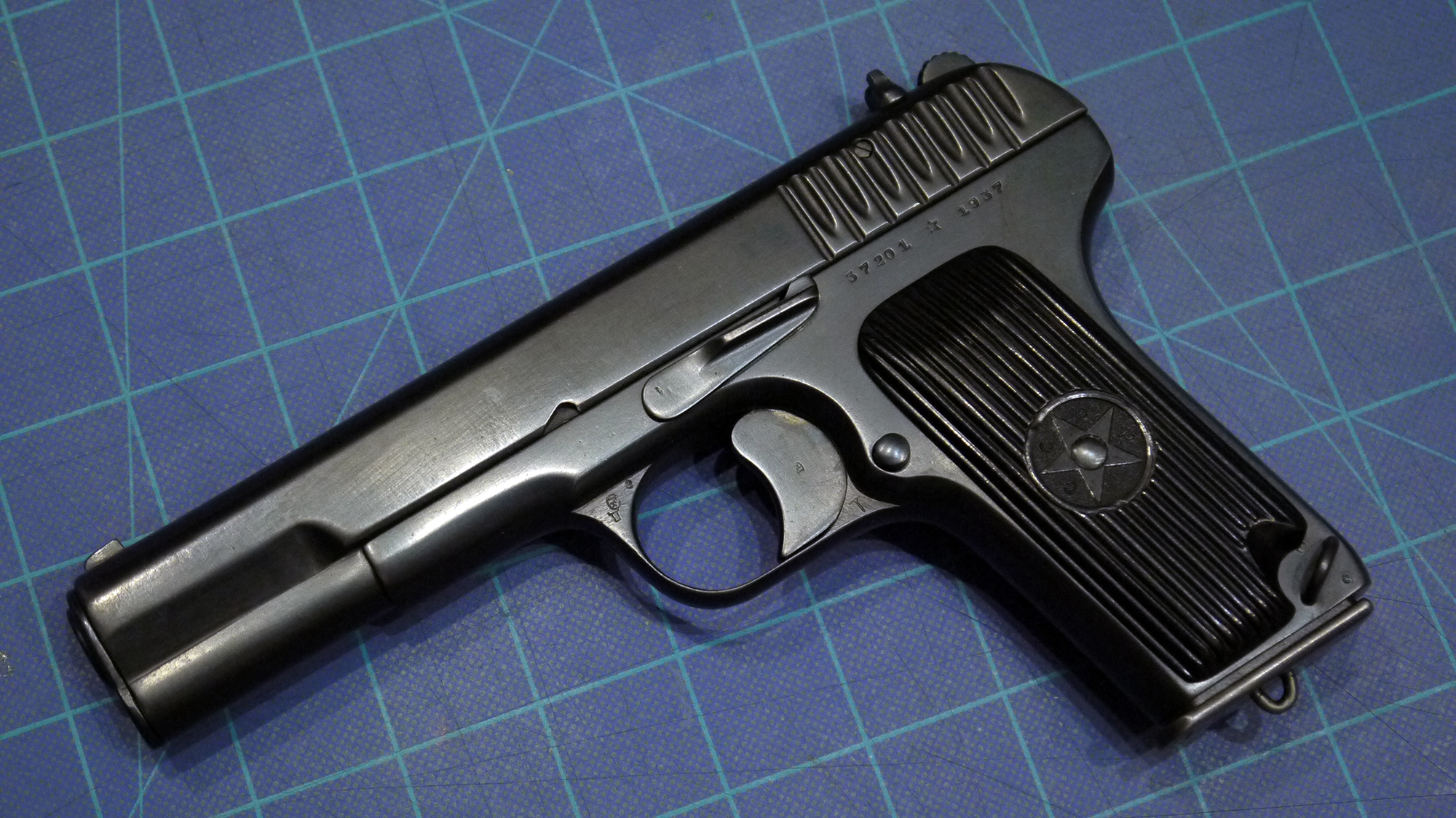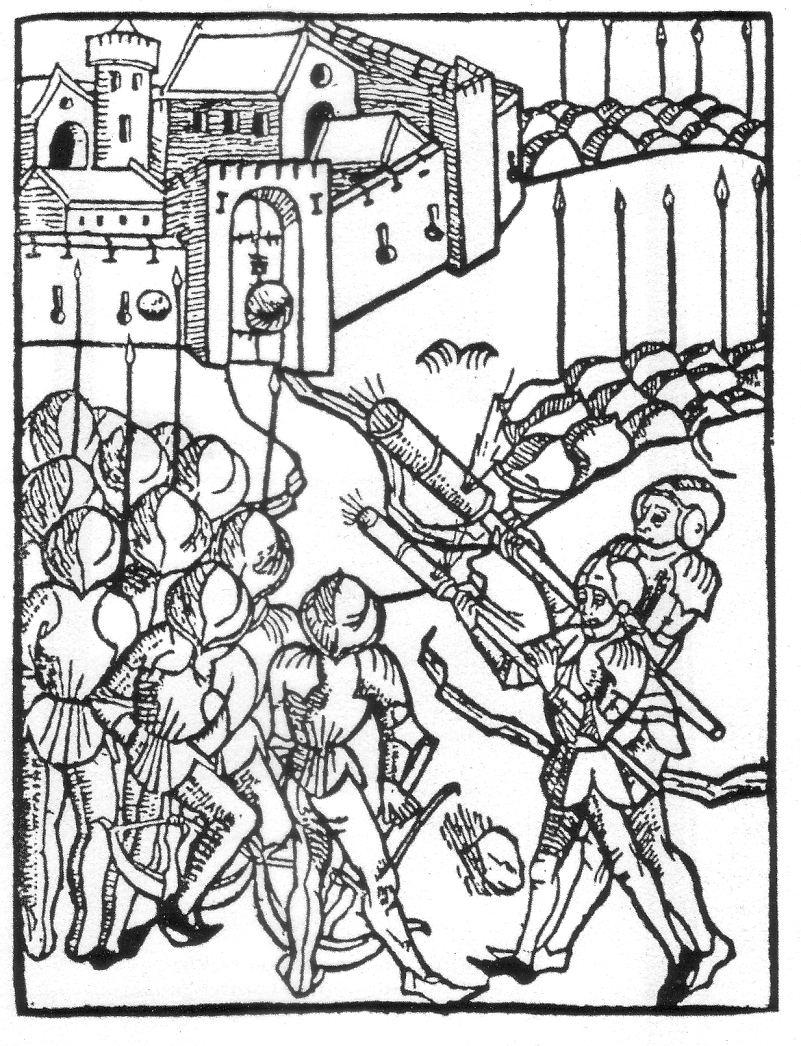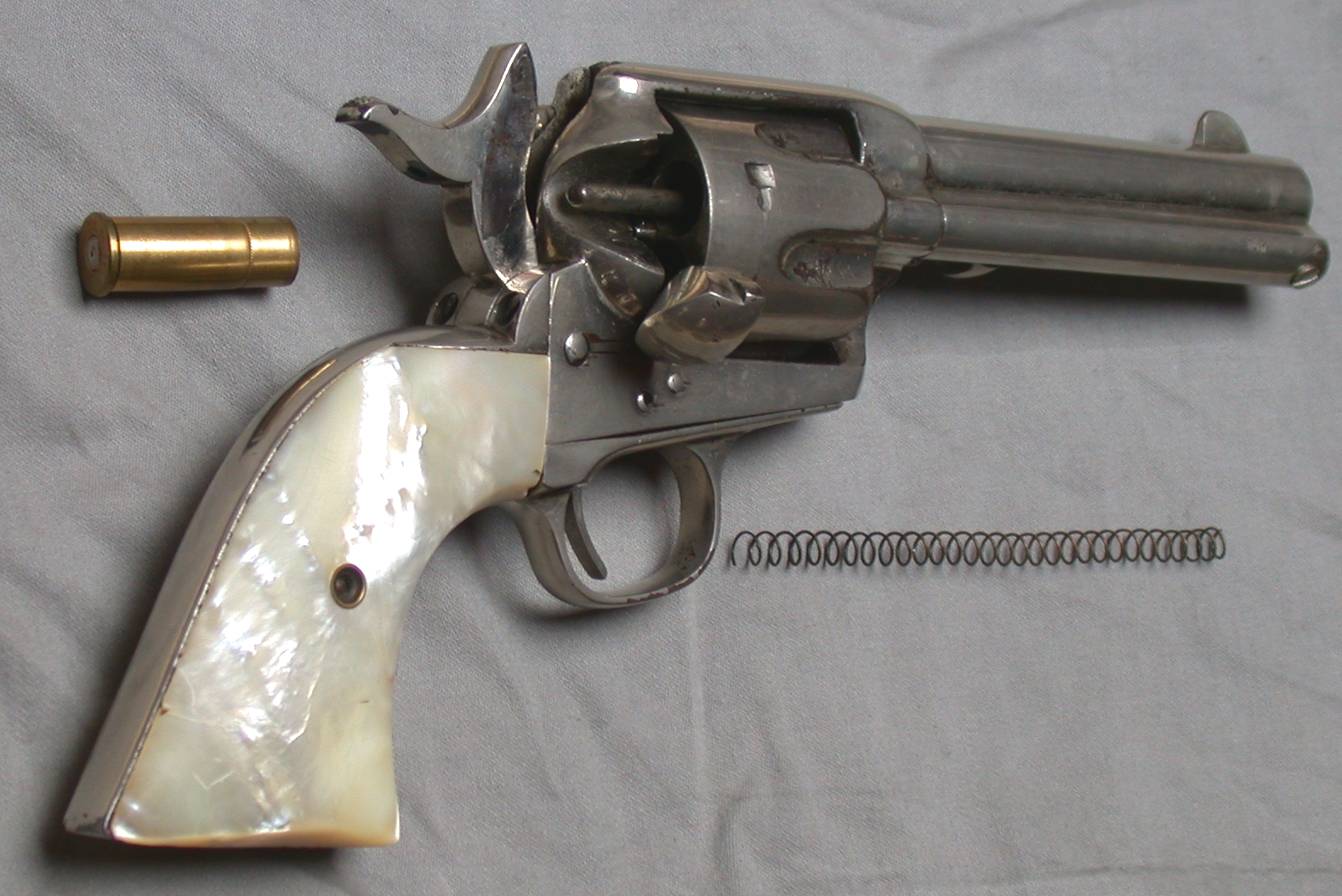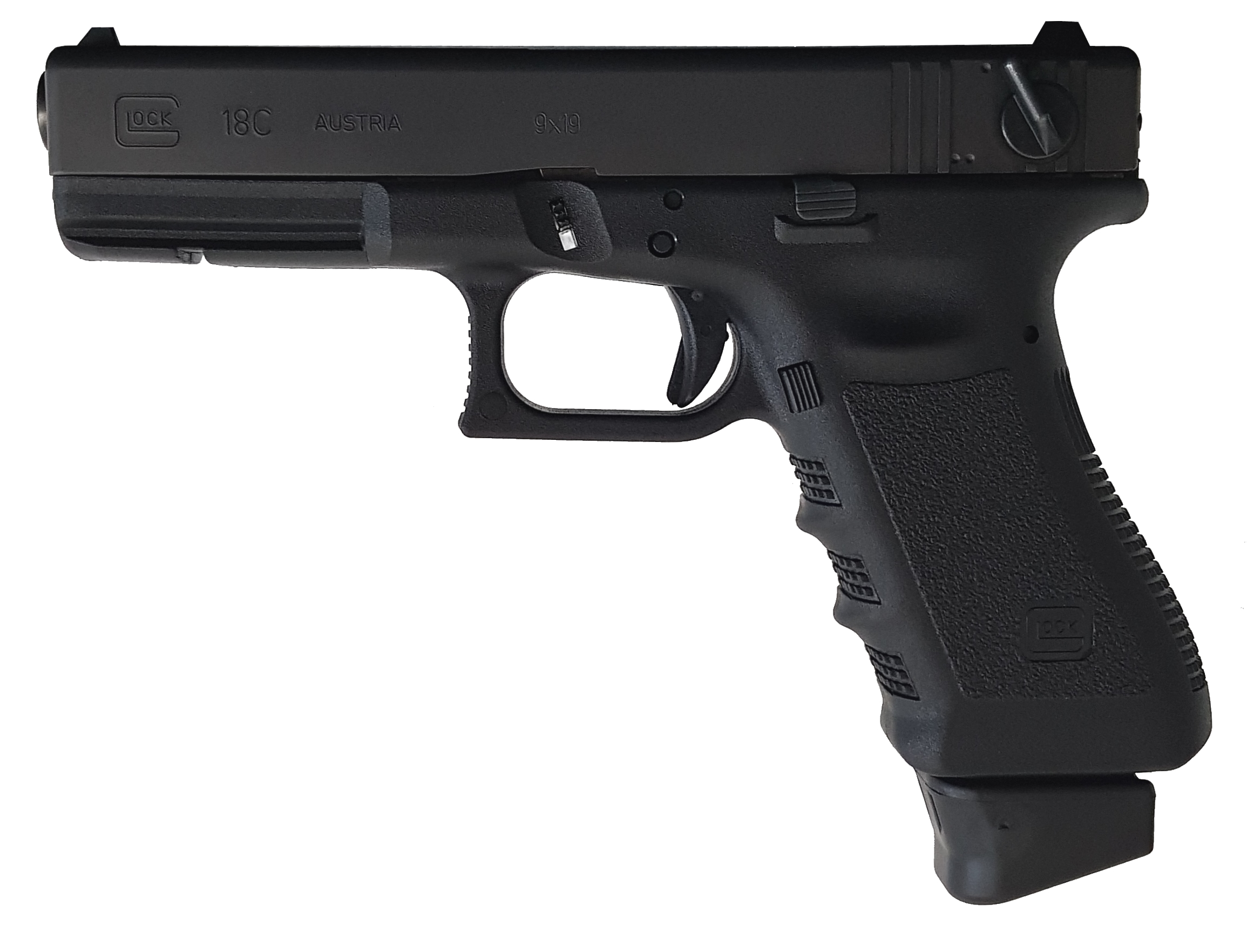Pistol on:
[Wikipedia]
[Google]
[Amazon]

 A pistol is a handgun, more specifically one with the
A pistol is a handgun, more specifically one with the
 The pistol originates in the 16th century, when early handguns were produced in Europe. The English word was introduced in ca. 1570 from the
The pistol originates in the 16th century, when early handguns were produced in Europe. The English word was introduced in ca. 1570 from the
 Single-shot handguns were mainly seen during the era of flintlock and musket weaponry where the pistol was loaded with a lead ball and fired by a flint striker, and then later a percussion cap. This shot required a reload every time it was shot. However, as technology improved, so did the single-shot pistol. New operating mechanisms were created, and due to this, they are still made today. They are the oldest type of pistol, and are often used to hunt wild
Single-shot handguns were mainly seen during the era of flintlock and musket weaponry where the pistol was loaded with a lead ball and fired by a flint striker, and then later a percussion cap. This shot required a reload every time it was shot. However, as technology improved, so did the single-shot pistol. New operating mechanisms were created, and due to this, they are still made today. They are the oldest type of pistol, and are often used to hunt wild
 With the development of the revolver, short for revolving pistol, in the 19th century, gunsmiths had finally achieved the goal of a practical capability for delivering multiple loads to one handgun barrel in quick succession. Revolvers feed
With the development of the revolver, short for revolving pistol, in the 19th century, gunsmiths had finally achieved the goal of a practical capability for delivering multiple loads to one handgun barrel in quick succession. Revolvers feed
 After the revolver, the semi-automatic pistol was the next step in the development of the pistol. By avoiding multiple chambers—which need to be individually reloaded—semi-automatic pistols delivered faster rates of fire and required only a few seconds to reload, by pushing a button or flipping a switch, and the magazine slides out to be replaced by a fully-loaded one. In blowback-type semi-automatics, the recoil force is used to push the slide back and eject the shell (if any) so that the magazine spring can push another round up; then as the slide returns, it chambers the round. An example of a modern blowback action semi-automatic pistol is the Walther PPK. Blowback pistols are some of the more simply designed handguns. Many semi-automatic pistols today operate using short-recoil. This design is often coupled with the Browning type tilting barrel.
After the revolver, the semi-automatic pistol was the next step in the development of the pistol. By avoiding multiple chambers—which need to be individually reloaded—semi-automatic pistols delivered faster rates of fire and required only a few seconds to reload, by pushing a button or flipping a switch, and the magazine slides out to be replaced by a fully-loaded one. In blowback-type semi-automatics, the recoil force is used to push the slide back and eject the shell (if any) so that the magazine spring can push another round up; then as the slide returns, it chambers the round. An example of a modern blowback action semi-automatic pistol is the Walther PPK. Blowback pistols are some of the more simply designed handguns. Many semi-automatic pistols today operate using short-recoil. This design is often coupled with the Browning type tilting barrel.
 A machine pistol is a pistol that is capable of burst-fire or fully automatic fire. The first machine pistol was produced by the
A machine pistol is a pistol that is capable of burst-fire or fully automatic fire. The first machine pistol was produced by the 
File:Обманка с пистолетами.jpg, Manner of Jean-François De le Motte (1625–1685). Still Life in Trompe-l'oeil Style With Pistols and a Henri Iv Medaillon
chamber
Chamber or the chamber may refer to:
In government and organizations
*Chamber of commerce, an organization of business owners to promote commercial interests
*Legislative chamber, in politics
*Debate chamber, the space or room that houses deliber ...
integral to its gun barrel
A gun barrel is a crucial part of gun-type weapons such as small firearms, artillery pieces, and air guns. It is the straight shooting tube, usually made of rigid high-strength metal, through which a contained rapid expansion of high-pres ...
, though in common usage the two terms are often used interchangeably. The English word was introduced in , when early handguns were produced in Europe, and is derived from the Middle French
Middle French (french: moyen français) is a historical division of the French language that covers the period from the 14th to the 16th century. It is a period of transition during which:
* the French language became clearly distinguished from t ...
''pistolet'' (), meaning a small gun or knife. In colloquial usage, the word "pistol" is often used to describe any type of handgun, inclusive of revolvers (which have a single barrel and a separate cylinder
A cylinder (from ) has traditionally been a three-dimensional solid, one of the most basic of curvilinear geometric shapes. In elementary geometry, it is considered a prism with a circle as its base.
A cylinder may also be defined as an ...
housing multiple chambers) and the pocket-sized derringers (which are often multi-barrelled).
The most common type of pistol used in the contemporary era
Contemporary history, in English-language historiography, is a subset of modern history that describes the historical period from approximately 1945 to the present. Contemporary history is either a subset of the late modern period, or it i ...
is the semi-automatic pistol, while the older single-shot and manual repeating pistols are now rarely seen and used primarily for nostalgic hunting
Hunting is the human activity, human practice of seeking, pursuing, capturing, or killing wildlife or feral animals. The most common reasons for humans to hunt are to harvest food (i.e. meat) and useful animal products (fur/hide (skin), hide, ...
and historical reenactment, and the fully automatic machine pistols are uncommon in civilian usage due to generally poor recoil-controllability and strict laws and regulations governing their manufacture and sale.
Terminology
Technically speaking, the term "pistol" is a hypernym generally referring to a handgun and predates the existence of the type of guns to which it now applied as a specific term, that is: in colloquial usage it is used as a hyponym to specifically describe pistols with a single integralchamber
Chamber or the chamber may refer to:
In government and organizations
*Chamber of commerce, an organization of business owners to promote commercial interests
*Legislative chamber, in politics
*Debate chamber, the space or room that houses deliber ...
within its barrel. The American '' Webster's Dictionary'' defines it as "a handgun whose chamber is integral with the barrel". This makes it distinct from the other types of handgun, such as the revolver, which has multiple chambers within a rotating cylinder
A cylinder (from ) has traditionally been a three-dimensional solid, one of the most basic of curvilinear geometric shapes. In elementary geometry, it is considered a prism with a circle as its base.
A cylinder may also be defined as an ...
that are separately aligned with a single barrel; and the derringer, which is a short pocket gun often with multiple single-shot barrels and no reciprocating action. The Bureau of Alcohol, Tobacco, Firearms, and Explosives (ATF) legally defines the term "pistol" as "a weapon
A weapon, arm or armament is any implement or device that can be used to deter, threaten, inflict physical damage, harm, or kill. Weapons are used to increase the efficacy and efficiency of activities such as hunting, crime, law enforcement, s ...
originally designed, made, and intended to fire
Fire is the rapid oxidation of a material (the fuel) in the exothermic chemical process of combustion, releasing heat, light, and various reaction products.
At a certain point in the combustion reaction, called the ignition point, flames ...
a projectile
A projectile is an object that is propelled by the application of an external force and then moves freely under the influence of gravity and air resistance. Although any objects in motion through space are projectiles, they are commonly found i ...
(bullet) from one or more barrels when held in one hand, and having: a chamber(s) as an integral part(s) of, or permanently aligned with, the bore(s); and a short stock designed to be gripped by one hand at an angle to and extending below the line of the bore(s)", which includes derringers but excludes revolvers.
In contrast with modern colloquial usage, the term is technically synonymous with ''any'' handgun type, including all revolvers and derringers. UK/ Commonwealth usage, for instance, does not usually make distinction, particularly when the terms are used by the military. For example, the official designation of the Webley Mk VI
The Webley Revolver (also known as the Webley Top-Break Revolver or Webley Self-Extracting Revolver) was, in various designations, a standard issue service pistol for the armed forces of the United Kingdom, and countries of the British Empire an ...
revolver was "Pistol, Revolver, Webley, No. 1 Mk VI". In contrast to the Merriam-Webster
Merriam-Webster, Inc. is an American company that publishes reference books and is especially known for its dictionaries. It is the oldest dictionary publisher in the United States.
In 1831, George and Charles Merriam founded the company as ...
definition, the Oxford English Dictionary
The ''Oxford English Dictionary'' (''OED'') is the first and foundational historical dictionary of the English language, published by Oxford University Press (OUP). It traces the historical development of the English language, providing a c ...
(a descriptive dictionary) describes "pistol" as "a small firearm
A firearm is any type of gun designed to be readily carried and used by an individual. The term is legally defined further in different countries (see Legal definitions).
The first firearms originated in 10th-century China, when bamboo tubes ...
designed to be held in one hand", which is similar to the Webster definition for "handgun"; and "revolver" as "a pistol with revolving chambers enabling several shots to be fired without reloading", giving its original form as "revolving pistol".
History and etymology
 The pistol originates in the 16th century, when early handguns were produced in Europe. The English word was introduced in ca. 1570 from the
The pistol originates in the 16th century, when early handguns were produced in Europe. The English word was introduced in ca. 1570 from the Middle French
Middle French (french: moyen français) is a historical division of the French language that covers the period from the 14th to the 16th century. It is a period of transition during which:
* the French language became clearly distinguished from t ...
''pistolet'' (ca. 1550).
The etymology of the French word ''pistolet'' is disputed. It may be from a Czech word for early hand cannons, ''píšťala'' ("whistle" or "pipe"), or alternatively from Italian ''pistolese'', after Pistoia, a city renowned for Renaissance-era gunsmithing, where hand-held guns (designed to be fired from horseback) were first produced in the 1540s.
The first suggestion derives the word from Czech ''píšťala'', a type of hand-cannon
The hand cannon (Chinese: 手 銃 ''shŏuchòng'', or 火 銃 ''huŏchòng''), also known as the gonne or handgonne, is the first true firearm and the successor of the fire lance. It is the oldest type of small arms as well as the most mec ...
used in the Hussite Wars
The Hussite Wars, also called the Bohemian Wars or the Hussite Revolution, were a series of civil wars fought between the Hussites and the combined Catholic forces of Sigismund, Holy Roman Emperor, Holy Roman Emperor Sigismund, the Papacy, Eur ...
during the 1420s. The Czech word was adopted in German as ''pitschale'', ''pitschole'', ''petsole'', and variants.
The second suggestion is less likely; the use of the word as a designation of a gun is not documented before 1605 in Italy, long after it was used in French and German. The Czech word is well documented since the Hussite wars in 1420s.
Action
Single-shot
 Single-shot handguns were mainly seen during the era of flintlock and musket weaponry where the pistol was loaded with a lead ball and fired by a flint striker, and then later a percussion cap. This shot required a reload every time it was shot. However, as technology improved, so did the single-shot pistol. New operating mechanisms were created, and due to this, they are still made today. They are the oldest type of pistol, and are often used to hunt wild
Single-shot handguns were mainly seen during the era of flintlock and musket weaponry where the pistol was loaded with a lead ball and fired by a flint striker, and then later a percussion cap. This shot required a reload every time it was shot. However, as technology improved, so did the single-shot pistol. New operating mechanisms were created, and due to this, they are still made today. They are the oldest type of pistol, and are often used to hunt wild game
A game is a structured form of play, usually undertaken for entertainment or fun, and sometimes used as an educational tool. Many games are also considered to be work (such as professional players of spectator sports or games) or art (suc ...
. Additionally, their compact size compared to most other types of handgun makes them more concealable.
Revolver
ammunition
Ammunition (informally ammo) is the material fired, scattered, dropped, or detonated from any weapon or weapon system. Ammunition is both expendable weapons (e.g., bombs, missiles, grenades, land mines) and the component parts of other we ...
via the rotation of a cartridge-filled cylinder
A cylinder (from ) has traditionally been a three-dimensional solid, one of the most basic of curvilinear geometric shapes. In elementary geometry, it is considered a prism with a circle as its base.
A cylinder may also be defined as an ...
, in which each cartridge is contained within its own ignition chamber, and is sequentially brought into alignment with the weapon's barrel by an indexing mechanism linked to the weapon's trigger ( double-action) or its hammer ( single-action). These nominally cylindrical chambers, usually numbering between five and eight depending on the size of the revolver and the size of the cartridge being fired, are bored through the cylinder so that their axes are parallel to the cylinder's axis of rotation; thus, as the cylinder rotates, the chambers revolve about the cylinder's axis.
Semi-automatic
 After the revolver, the semi-automatic pistol was the next step in the development of the pistol. By avoiding multiple chambers—which need to be individually reloaded—semi-automatic pistols delivered faster rates of fire and required only a few seconds to reload, by pushing a button or flipping a switch, and the magazine slides out to be replaced by a fully-loaded one. In blowback-type semi-automatics, the recoil force is used to push the slide back and eject the shell (if any) so that the magazine spring can push another round up; then as the slide returns, it chambers the round. An example of a modern blowback action semi-automatic pistol is the Walther PPK. Blowback pistols are some of the more simply designed handguns. Many semi-automatic pistols today operate using short-recoil. This design is often coupled with the Browning type tilting barrel.
After the revolver, the semi-automatic pistol was the next step in the development of the pistol. By avoiding multiple chambers—which need to be individually reloaded—semi-automatic pistols delivered faster rates of fire and required only a few seconds to reload, by pushing a button or flipping a switch, and the magazine slides out to be replaced by a fully-loaded one. In blowback-type semi-automatics, the recoil force is used to push the slide back and eject the shell (if any) so that the magazine spring can push another round up; then as the slide returns, it chambers the round. An example of a modern blowback action semi-automatic pistol is the Walther PPK. Blowback pistols are some of the more simply designed handguns. Many semi-automatic pistols today operate using short-recoil. This design is often coupled with the Browning type tilting barrel.
Machine pistol
 A machine pistol is a pistol that is capable of burst-fire or fully automatic fire. The first machine pistol was produced by the
A machine pistol is a pistol that is capable of burst-fire or fully automatic fire. The first machine pistol was produced by the Austro-Hungarian Empire
Austria-Hungary, often referred to as the Austro-Hungarian Empire,, the Dual Monarchy, or Austria, was a constitutional monarchy and great power in Central Europe between 1867 and 1918. It was formed with the Austro-Hungarian Compromise of ...
in 1916, as the ''Steyr Repetierpistole'' M1912/P16, and the term is derived from the German word ''maschinenpistolen''. Though it is often used interchangeably with submachine gun
A submachine gun (SMG) is a magazine-fed, automatic carbine designed to fire handgun cartridges. The term "submachine gun" was coined by John T. Thompson, the inventor of the Thompson submachine gun, to describe its design concept as an autom ...
, a machine pistol is generally used to describe a weapon that is more compact than a typical submachine gun.
How it works: The shooter will disable the safety switch and pull the trigger, but hold it unlike firing a normal semi-automatic. The handgun will fire one round, and recoils, and the high-capacity magazine spring pushes another round, and is chambered, and fired without any actions needed from the shooter. They are useful in situations where multiple bullets must be fired in quick succession with minimal effort.
Multi-barreled
Multi-barreled pistols, such as the Pepperbox, were common during the same time as single shot pistols. As designers looked for ways to increase fire rates, multiple barrels were added to all guns including pistols. One example of a multi-barreled pistol is theCOP .357 Derringer
The COP .357 is a 4-shot Derringer-type pistol chambered for .357 Magnum. The double-action weapon is about twice as wide, and substantially heavier than the typical .25 automatic pistol, though its relatively compact size and powerful cartridge ...
.
Harmonica pistol
Around 1850, pistols such as the Jarreharmonica gun
A harmonica gun or slide gun is a form of firearm which was breech loaded with a steel slide, containing a number of chambers bored in it and which were filled with projectiles. Most harmonica guns are percussion cap guns, although some design ...
were produced that had a sliding magazine. The sliding magazine contained pinfire cartridges or speedloaders. The magazine needed to be moved manually in many designs, hence distinguishing them from semi-automatic pistols.
Lever-action
Lever action pistols are very rare, the most notable of which is the Volcanic pistol.Gallery of evolution of pistols over 400 years
7th Century
The 7th century is the period from 601 ( DCI) through 700 ( DCC) in accordance with the Julian calendar in the Common Era. The spread of Islam and the Muslim conquests began with the unification of Arabia by Muhammad starting in 622. After Mu ...
File:Cornelius Norbertus Gijsbrechts (1657-1683), Trompe l'oeil med pistoler, 1672 Kms3062.jpg, Cornelis Norbertus Gijsbrechts
Cornelis Norbertus Gijsbrechts or Gysbrechts (1625/1629 – after 1675) was a Flemish painter who was active in the Spanish Netherlands, Germany, Denmark and Sweden in the second half of the seventeenth century.Läckö Castle
Läckö Castle (Swedish language, Swedish: '':sv:Läckö slott, Läckö Slott'' ) is a medieval castle in Sweden, located on Kållandsö island on Lake Vänern, 25 kilometers north of Lidköping in Västergötland, Sweden.
History
Brynolf Algo ...
.
File:William Michael Harnett 001.jpg, "The Faithful Colt" 1890 by William Michael Harnett
William Michael Harnett (August 10, 1848 – October 29, 1892) was an Irish-American painter known for his trompe-l'œil still lifes of ordinary objects.
Early life
Harnett was born in Clonakilty, County Cork, Ireland during the time of the Gr ...
File:M1911_A1_pistol.jpg, The M1911, an early semi-automatic pistol
File:CZ_75_SP-01.jpg, The CZ-75, one of the most successful Wonder Nines
File:Westdog-lds-mp5k_001.JPG, An MP5K
The Heckler & Koch MP5 (german: Maschinenpistole 5) is a 9x19mm Parabellum submachine gun, developed in the 1960s by a team of engineers from the German small arms manufacturer Heckler & Koch. There are over 100 variants and clones of the MP5, ...
machine pistol
See also
*Glossary of firearms terms
The following are terms related to firearms and ammunition topics.
A
*Accurize, accurizing: The process of altering a stock firearm to improve its accuracy.
*Action: The physical mechanism that manipulates cartridges and/or seals the breech ...
* List of pistols
* Pistol grip
* Water gun, including water pistol and squirt gun
References
{{Authority control Handguns 16th-century introductions